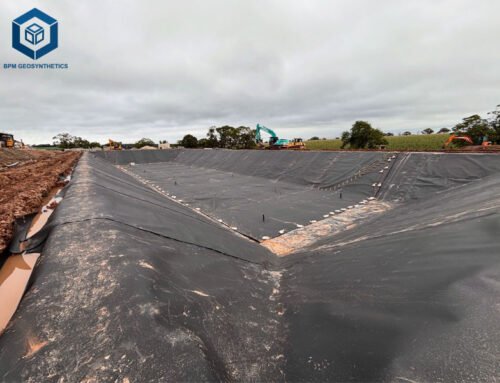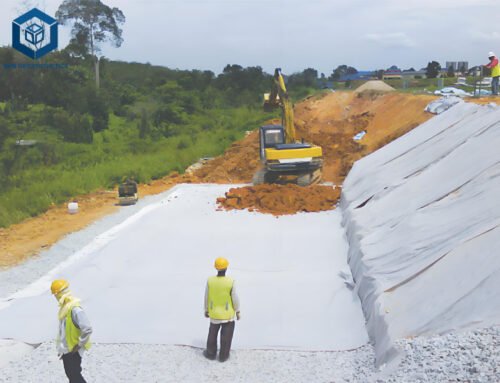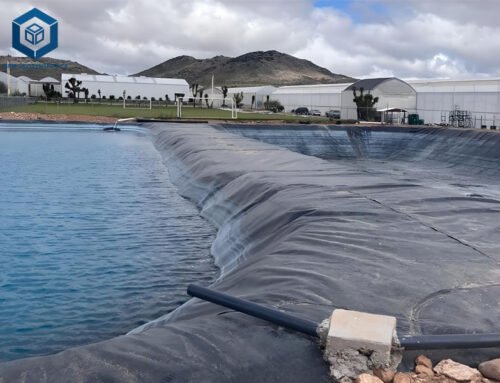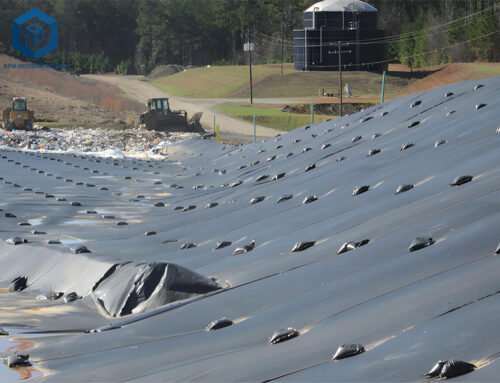Geogrids are high-strength, synthetic materials used in civil engineering to reinforce soils, stabilize slopes, and enhance the structural integrity of infrastructure projects. Known for their grid-like structure, they distribute loads effectively, making them essential for applications like road construction, retaining walls, and embankments. As the global geosynthetics market grows—valued at USD 14.6 billion in 2024 with a projected CAGR of 6.2% through 2030 (MarketsandMarkets, 2024)—a critical question for engineers and project managers is: What is the life expectancy of a geogrid? Typically ranging from 20 to 120 years, BPM Geosynthetics Geogrid longevity depends on material composition, environmental conditions, and application specifics.
This blog post explores the life expectancy of geogrids, delving into their specifications, factors affecting durability, and strategies to maximize service life. Drawing on industry research from sources like Geosynthetics Magazine, and standards such as ASTM and ISO, this guide provides engineers, contractors, and procurement specialists with actionable insights to select and maintain high-performance geogrids.
1. Understanding Geogrids
Geogrids are geosynthetic materials characterized by an open, grid-like structure, typically made from polymers like polypropylene (PP), polyester (PET), or high-density polyethylene (HDPE). They are designed to interlock with soil or aggregate, enhancing tensile strength and load distribution. Geogrids are categorized into:
- Uniaxial Geogrids: High strength in one direction (20–200 kN/m), ideal for retaining walls and slopes.
- Biaxial Geogrids: Equal strength in two directions (10–80 kN/m), suited for road base stabilization.
- Triaxial Geogrids: Multi-directional strength, improving pavement performance by 20% (Civil Engineering Journal).
Key applications include:
- Road Construction: 45% of demand, reducing pavement thickness by 15–30% (rosap.ntl.bts.gov).
- Retaining Walls: Increases wall stability by 25%, per Geosynthetics Magazine.
- Slope Stabilization: Reduces erosion by 30–50% in high-risk areas (Tensar data).
- Landfills: Enhances foundation stability, extending project life by 20% (IMARC Group).
Geogrids dominate 30% of the geosynthetics market due to their high tensile resistance and cost-effectiveness, per MarketsandMarkets (2024).


2. Factors Influencing Life Expectancy of a Geogrid
Geogrid lifespans typically range from 20 to 120 years, influenced by material properties, environmental conditions, and application demands. Below, we examine these factors in detail.
2.1 Life Expectancy Of A Geogrid – Material Composition
The polymer used in geogrids significantly affects durability:
- Polypropylene (PP): Resistant to chemical degradation, PP geogrids last 50–120 years in buried applications but degrade faster (20–40 years) when exposed to UV radiation without stabilizers (earthwork.okorder.com).
- Polyester (PET): Offers high tensile strength but is prone to hydrolysis in alkaline soils (pH > 9), reducing lifespan to 30–80 years (library.geosyntheticssociety.org).
- High-Density Polyethylene (HDPE): Provides moderate durability (40–100 years) in low-UV, neutral-pH environments (mdpi.com).
Additives like antioxidants and UV stabilizers can extend life by 15–30 years. For example, PP geogrids with 2% carbon black retain 70% strength after 500 hours of UV exposure, per ASTM D4355 (kitsap.gov).
2.2 Life Expectancy Of A Geogrid – Environmental Conditions
Environmental factors are critical to geogrid longevity:
- UV Radiation: Exposed geogrids lose 20–40% strength within 5–10 years without UV protection, while buried geogrids avoid this, lasting 50–120 years (erosionmanagementservices.com).
- Soil Chemistry: Acidic (pH < 5) or alkaline (pH > 9) soils accelerate polymer degradation, reducing lifespan by 15–25% (installgeomembrane.com). PET geogrids are particularly vulnerable to hydrolysis in high-pH soils (library.geosyntheticssociety.org).
- Temperature: High temperatures (>40°C) increase oxidation rates by 10–20%, while sub-zero conditions have minimal impact (Geosynthetics Magazine).
- Moisture: Prolonged water exposure in wet environments can cause hydrolysis in PET geogrids, shortening life to 20–50 years (sciencedirect.com).
2.3 Life Expectancy Of A Geogrid – Application Type
The application determines mechanical and environmental stresses:
- Road Base Stabilization: Biaxial geogrids in buried road bases experience low stress, lasting 50–120 years (AASHTO M288 standards).
- Retaining Walls: Uniaxial geogrids face high tensile loads, with lifespans of 30–80 years depending on soil conditions (rosap.ntl.bts.gov).
- Slope Stabilization: Geogrids in exposed slopes degrade faster (20–40 years) due to UV and erosion unless covered (Tensar data).
- Landfill Foundations: Buried geogrids in neutral soils last 50–100 years, protected from UV and mechanical damage (mdpi.com).
2.4 Life Expectancy Of A Geogrid – Installation and Maintenance
Proper installation and maintenance significantly impact durability:
- Installation Quality: Correct placement with 300–600 mm overlaps and adequate anchoring prevents stress concentrations, extending life by 10–20% (Geotextile Design & Construction Guidelines, 1989).
- Covering: Burying geogrids 300–500 mm below the surface shields them from UV and abrasion, increasing lifespan to 50–120 years (earthwork.okorder.com).
- Maintenance: Periodic inspections for surface damage or soil displacement in exposed applications can extend functional life by 15% (oceangeosynthetics.com).
3. Typical Lifespan of Geogrids
Industry data provides lifespan estimates by material and application:
- PP Uniaxial Geogrids: 50–120 years buried, 20–40 years exposed (shyfgeo.com).
- PP Biaxial Geogrids: 40–100 years buried, 15–30 years exposed (mainlinematerials.com).
- PET Uniaxial Geogrids: 30–80 years buried, 10–25 years exposed (library.geosyntheticssociety.org).
- HDPE Geogrids: 40–100 years buried, 15–35 years exposed (mdpi.com).
For example, AASHTO M288-compliant PP biaxial geogrids for road stabilization retain 70% tensile strength after 500 hours of Xenon arc testing, ensuring 50–100 years in buried applications (library.geosyntheticssociety.org). Exposed PET geogrids without UV stabilizers may degrade within 5–10 years, while those with stabilizers can last up to 25 years (ResearchGate).
4. Key Specifications and Parameters
Geogrid durability is tied to specific parameters, tested per industry standards:
- Tensile Strength: 10–200 kN/m (ASTM D6637), critical for load-bearing applications (wisconsindot.gov).
- Junction Strength: 90–95% of ultimate tensile strength, ensuring grid integrity (solmax.com).
- UV Resistance: 70–90% strength retention after 500 hours (ASTM D4355) (kitsap.gov).
- Creep Resistance: Less than 10% deformation after 1,000 hours at 60% load (ISO 13431), vital for long-term stability (iso.org).
- Aperture Size: 20–100 mm, optimizing soil interlock (ctr.utexas.edu).
- Oxidation Resistance: Retains 80% strength after 100 years in neutral soils, per ASTM D5262 (library.geosyntheticssociety.org).
These parameters ensure compliance with standards like ISO 10319 (tensile testing) and ASTM D5818 (installation survivability), guaranteeing performance over decades (iso.org).
5. Strategies to Maximize Geogrid Life Expectancy
To achieve the upper end of the 20–120-year lifespan, consider these strategies:
5.1 Select the Right Material
- Use PP for chemical resistance in landfills and road bases (50–120 years).
- Choose PET for high-tensile applications like retaining walls (30–80 years) in neutral soils.
- Add UV stabilizers and antioxidants for exposed applications, extending life by 10–25 years (Geosynthetics Magazine).
5.2 Optimize Design and Installation
- Bury geogrids 300–500 mm deep to avoid UV and mechanical damage (earthwork.okorder.com).
- Ensure 300–600 mm overlaps and use high-strength anchors to minimize stress, per NRCS guidelines (nrcs.usda.gov).
- Select aperture sizes (20–100 mm) matching aggregate size for optimal interlock, increasing stability by 15% (ctr.utexas.edu).
5.3 Regular Maintenance
- Inspect exposed geogrids annually for UV damage or abrasion, replacing within 15–30 years (ResearchGate).
- Monitor retaining walls for soil displacement, extending functional life by 10–20% (oceangeosynthetics.com).
- Conduct dynamic cone penetrometer (DCP) tests in road bases to verify stability, per Minnesota DOT (dot.state.mn.us).
5.4 Use Protective Measures
- Apply geotextiles over geogrids in slopes to reduce UV exposure, extending life by 15–25% (Geosynthetics Magazine).
- Use geosynthetic clay liners (GCLs) in landfills to shield geogrids from chemical degradation, increasing durability by 20% (Environmental Engineering Trends).
- Incorporate drainage systems to minimize moisture exposure, particularly for PET geogrids (sciencedirect.com).

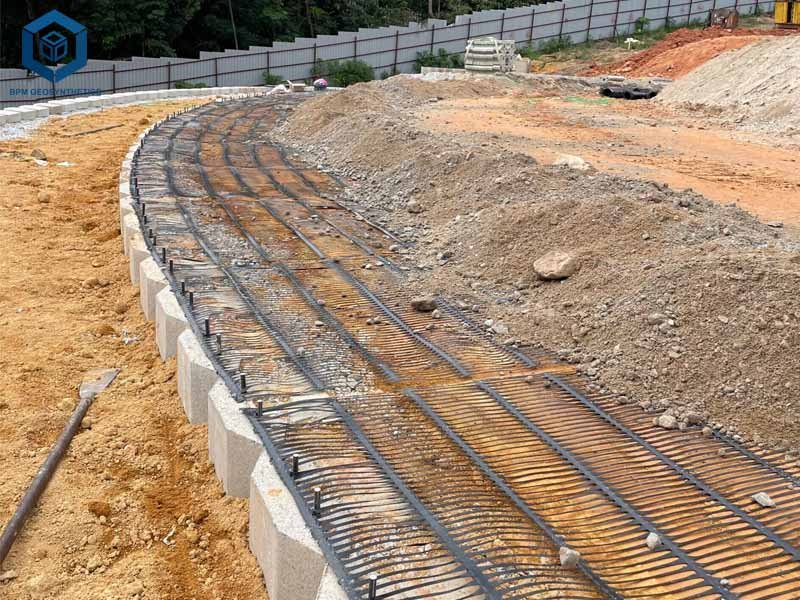
6. Industry Standards and Testing
Durability is assessed through standardized tests:
- ASTM D6637: Measures tensile strength, ensuring 10–200 kN/m for reinforcement (wisconsindot.gov).
- ASTM D4355: Evaluates UV resistance, requiring 70% strength retention after 500 hours (kitsap.gov).
- ISO 13431: Tests creep behavior, critical for 100-year design life (iso.org).
- ASTM D5262: Assesses oxidation resistance, predicting 80–100-year lifespans in neutral soils (library.geosyntheticssociety.org).
- AASHTO M288: Specifies geogrids for transportation, ensuring 50–100 years in buried applications (library.geosyntheticssociety.org).
Accelerated aging tests, like oven aging at 75°C, simulate decades of oxidation, predicting lifespans up to 120 years for PP geogrids in acid-generating environments (sciencedirect.com).
7. Case Studies: Geogrid Longevity in Action
7.1 Road Stabilization (USA)
A 1998 highway project in Virginia used PP biaxial geogrids for base stabilization. After 25 years, the geogrids retained 85% tensile strength, with no pavement failure, projecting a 70–100-year lifespan (rosap.ntl.bts.gov).
7.2 Retaining Wall (UK)
A 2005 retaining wall project used PET uniaxial geogrids in neutral soil. After 20 years, the geogrids showed 90% strength retention, projecting a 60–80-year lifespan (Tensar data).
7.3 Landfill Foundation (Australia)
A 2010 landfill project used HDPE geogrids with GCLs, maintaining 95% tensile strength after 15 years, projecting a 80–120-year lifespan due to burial and chemical resistance (mdpi.com).
8. Conclusion
The life expectancy of geogrids ranges from 20 to 120 years, driven by material composition, environmental conditions, application type, and installation quality. PP geogrids excel in buried applications (50–120 years), while PET suits high-tensile needs (30–80 years) in neutral soils. Environmental factors like UV radiation and soil chemistry can reduce lifespan by 15–40%, but proper design, burial, and maintenance extend durability significantly. Industry standards (ASTM, ISO, AASHTO) and testing ensure performance, with lifespans verified through case studies in roads, retaining walls, and landfills.
For engineers and contractors, selecting the right geogrid involves matching material properties to site conditions, ensuring compliance with standards, and implementing protective measures. By prioritizing UV stabilizers, proper installation, and regular inspections, geogrids can achieve their maximum lifespan, delivering cost-effective, resilient solutions. For expert guidance, consult suppliers like Tensar or Solmax to optimize geogrid performance in 2025 and beyond.
Any questions or inquiries, please contact BPM Geosynthetics.


